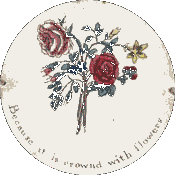Shop for a 50s Dress, Rocking Chair and Unraveling Knitted Calendars and a Persistence of Vision Toy
We're admirers of the Victoria and Albert Museum's shop; shipping to the US is relatively painless (though not cheap), though not all items are shipped. Some items, however, have been consistently carried over the past couple of years, including a range of 50s-style fashions popular in the United Kingdom, on display in the museum and copied.
Consider the 1950s 'Rose & Bow' Dress (Size 12), a design adopted from a Steiner pattern. The dress is developed from an original 1950s day dress in the V&A's archives. Fitted waist and boice, free hips, 100 % cotton. The dress is worn over a productions "Superwhoosh" 1950s petticoat for additional volume. There's a Mauve Stripe Slip (Large) whose design is adapted from a fabric designed by Joyce Badrocke for Horrockses Fashions, 1950s in the V&A's archives. And don't overlook the zwoosh underskirt.
Other unusual items include a rocking chair calendar that's set up and display the months. Continuing the calendar theme, consider the Unraveling Knitted Calendar for 2012. (*Available to pre-order, due September 2011*). This is a very, very long knitted scarf; pull down the thread at the bottom of the scarf to unravel the days until you reach the end of the year. (Includes wood hanger). And holiday cards have arrived.
The Museum of Childhood has it's own separate section, including the Dictionary of Children's Clothes. a mini-Pengun fan and tiger mittens. There are over 15 pages of jewelry including a sunset moth necklace inspired by the vivid colors and detail seen in the florilegia, or botanical illustrations of the 18th century by artists such as George Dionysus Ehret.
We have no idea of what motorway masking tape is. Racers tape? But then again the shop features a Thaumatrope' Optical Toy:
"The Thaumatrope was a popular optical toy of the nineteenth-century. Cards that were usually either circular or rectangular were printed with a picture on each side. When the card was spun, sometimes using attached pieces of string, one complete image was formed. A popular example was a bird and a cage. The images were often humorous and this set features a boy being thrown from a donkey and a bull chasing a man. The illusion is created due to the phenomenon know as 'persistence of vision'. This is when the eye will remember an image for a brief moment and, given two images to see in a short space of time, will combine them. "






